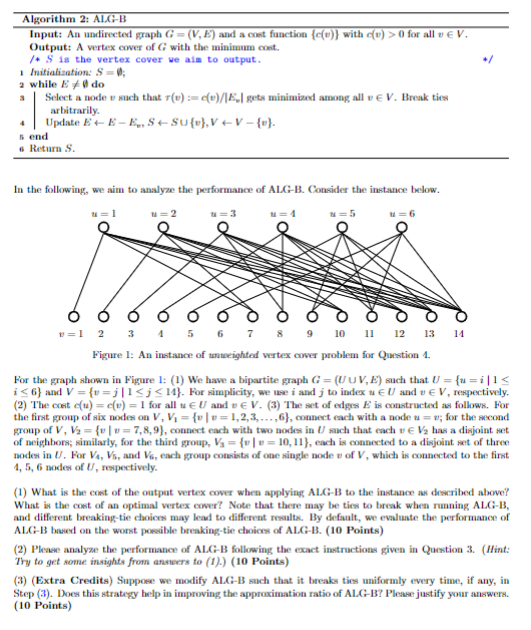Answered step by step
Verified Expert Solution
Question
1 Approved Answer
Algorithm 2 : AL . C: - B Input: An undirected graph G = ( V , E ) and a coest function { c
Algorithm : ALC:B
Input: An undirected graph and a coest function with for all vinV.
Output: A vertex cover of with the minimum cost.
is the vertex cover ve ais to output.
Initialization: ;
while do
Select a node such that : gets minimized among all vinV. Break ties
arbitrarily.
Update ElarrESlarrSVlarrV
end
Return
In the following, we aim to analyze the performance of ALCB Consider the instance below.
Figure : An instance of unuecighted vertex cover problem for Question
For the graph shown in Figure : We have a bipartite graph such that
and For simplicity, we use i and to index uinU and vinV, respectively.
The cost for all uinU and vinV. The set of edges is constructed as follows. For
the first group of six nodes on dots, conect each with a node ; for the scond
group of connect each with two nodes in such that each has a disjoint set
of neighbors; similarly, for the third group, each is conaected to a disjoint set of three
nodes in For and each group consists of one single node of which is connected to the first
nodes of respectively.
What is the cost of the output vertex cover when applying ALC:B to the instanox as described above?
What is the cost of an optimal vertex cower? Note that there may be ties to break when rumaing ALCB
and different breakingtie choics may lead to different resalts. By default, we evaluate the performance of
ALC:B based on the worst poesible breakingtie choios of ALC:B Points
Plewe analyze the performaner of ALCB following the exact instructions given in Question In the class, we have discussed a GreedyBased algorithm for weighted Vertex Cover Problem
VCP Below is a formal statement.
Algorithm : ALGB
Input: An undirected graph G V E and a cost function cv with cv for all v in V
Output: A vertex cover of G with the minimum cost.
S is the vertex cover we aim to output.
Initialization: S ;
while E do
Select a node v such that tau v : cvEv gets minimized among all v in V Break ties
arbitrarily.
Update E E Ev S S cup v V V v
end
Return S
In the following, we aim to analyze the performance of ALGB Consider the instance below.
u u u u u u
v
Figure : An instance of unweighted vertex cover problem for Question
For the graph shown in Figure : We have a bipartite graph G U cup V E such that U u i
i and V v j j For simplicity, we use i and j to index u in U and v in V respectively.
The cost cu cv for all u in U and v in V The set of edges E is constructed as follows. For
the first group of six nodes on V Vv v connect each with a node u v; for the second
group of V Vv v connect each with two nodes in U such that each v in V has a disjoint set
of neighbors; similarly, for the third group, Vv v each is connected to a disjoint set of three
nodes in U For V V and V each group consists of one single node v of V which is connected to the first
nodes of U respectively.
What is the cost of the output vertex cover when applying ALGB to the instance as described above?
What is the cost of an optimal vertex cover? Note that there may be ties to break when running ALGB
and different breakingtie choices may lead to different results. By default, we evaluate the performance of
ALGB based on the worst possible breakingtie choices of ALGB

Step by Step Solution
There are 3 Steps involved in it
Step: 1

Get Instant Access to Expert-Tailored Solutions
See step-by-step solutions with expert insights and AI powered tools for academic success
Step: 2

Step: 3

Ace Your Homework with AI
Get the answers you need in no time with our AI-driven, step-by-step assistance
Get Started


